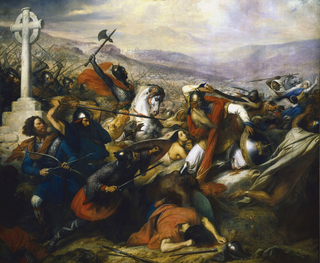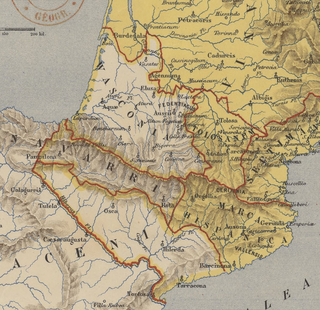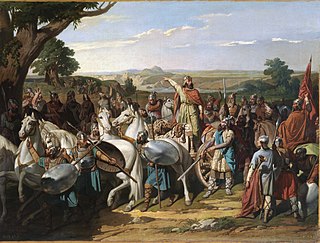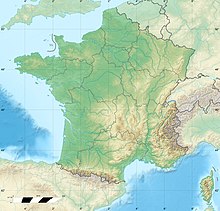The 750s decade ran from January 1, 750, to December 31, 759.
The 730s decade ran from January 1, 730, to December 31, 739.

Year 752 (DCCLII) was a leap year starting on Saturday of the Julian calendar. The denomination 752 for this year has been used since the early medieval period, when the Anno Domini calendar era became the prevalent method in Europe for naming years.

The Battle of Tours, also called the Battle of Poitiers and, by Arab sources, the Battle of the Highway of the Martyrs, was fought on 10 October 732, and was an important battle during the Umayyad invasion of Gaul. It resulted in victory by the Frankish and Aquitainian forces under Charles Martel over the Umayyad Caliphate led by Abdul Rahman Al Ghafiqi, Governor-General of al-Andalus.

Septimania is a historical region in modern-day southern France. It referred to the western part of the Roman province of Gallia Narbonensis that passed to the control of the Visigoths in 462, when Septimania was ceded to their king, Theodoric II. The regions was also variously known as Gallia, Arbuna or Narbonensis. Septimania territory roughly corresponds with the modern French former administrative region of Languedoc-Roussillon that merged into the new administrative region of Occitanie. Septimania was conquered by the Muslims in the 8th century and was known as Arbuna and remained part of the Al-Andalus. It passed briefly to the Emirate of Córdoba, which had been expanding from the south during the eighth century before its subsequent conquest by the Franks, who by the end of the ninth century termed it Gothia or the Gothic March.

Villeneuve-lès-Maguelone is a commune in the Hérault department in the Occitanie region in southern France.

The Hispanic Marches or Spanish Marches, also known as the March of Barcelona, were a military buffer zone beyond the former province of Septimania, established by Charlemagne in 795 as a defensive barrier between the Umayyad Moors of Al-Andalus and the Frankish Carolingian Empire.
The history of Toulouse, in Midi-Pyrénées, southern France, traces back to ancient times. After Roman rule, the city was ruled by the Visigoths and Merovingian and Carolingian Franks. Capital of the County of Toulouse during the Middle Ages, today it is the capital of the Midi-Pyrénées region.
Ansemund was the Gothic count of Nîmes, ruling from 752 until his death in 754.

The Umayyadconquest of Hispania, also known as the Muslim conquest of the Iberian Peninsula or the Umayyad conquest of the Visigothic Kingdom, was the initial expansion of the Umayyad Caliphate over Hispania from 711 to 718. The conquest resulted in the destruction of the Visigothic Kingdom and the establishment of the Umayyad wilaya of Al-Andalus. The conquest marks the westernmost expansion of both the Umayyad Caliphate and Muslim rule into Europe.

Pepin the Short was the King of the Franks from 751 until his death in 768. He was the first of the Carolingians to become king.
Al-Samh ibn Malik al-Khawlani was the Arab governor general of Al-Andalus from between 719 and 721.
Waiofar, also spelled Waifar, Waifer or Waiffre, was the last independent Duke of Aquitaine from 745 to 768. He peacefully succeeded his father, Hunald I, after the latter entered a monastery. He also inherited the conflict with the rising Carolingian family and its leader, Pepin the Short, who was king of the Franks after 751 and thus Waiofar's nominal suzerain.

The Siege of Avignon, in which Frankish forces led by Charles Martel beat the Umayyad garrison of Avignon and destroyed the stronghold, was contested in 737.

The Siege of Narbonne was fought in 737 between the forces of Yusuf ibn 'Abd al-Rahman al-Fihri, Umayyad governor of Narbonne, and a Frankish army led by Charles Martel.
Yusuf ibn Abd al-Rahman al-Fihri was an Umayyad governor of Narbonne in Septimania and governor of al-Andalus from 747 to 756, ruling independently following the collapse of the Umayyad Caliphate in 750. He was a descendant of Uqba ibn Nafi, the founder of Kairouan.
At the Battle of the River Berre in 737 Frankish forces under the command of Charles Martel intercepted a sizeable Arab force sent from Al-Andalus and led by Uqba ibn al-Hayyay to relieve the siege of Narbonne. The battle, which took place at the mouth of the River Berre, was a significant victory for Martel in the campaigns of 736–737. During this period Martel effectively prevented greater Umayyad expansion beyond the Pyrenees.
ʿAbd al-Raḥmān ibn Ḥabīb al-Fihrī was an Arab noble of the Oqbid or Fihrid family, and ruler of Ifriqiya from 745 through 755 AD.
Septimania was the western region of the Roman province of Gallia Narbonensis that passed under the control of the Visigoths in 462. It passed briefly to the Emirate of Córdoba in the eighth century before its reconquest by the Franks, who by the end of the ninth century termed it Gothia. This article presents a timeline of its history.

The Umayyad invasion of Gaul occurred in two phases in 719 and 732. Although the Muslim Umayyads secured control of Septimania, their incursions beyond this into the Loire and Rhône valleys failed. By 759 they had lost Septimania to the Christian Franks.










